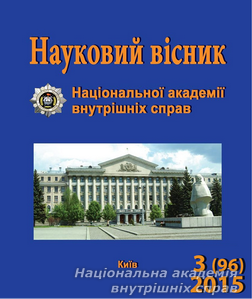The interaction of operational units with state financial inspection of Ukraine in the process of identifying and fixing offenses in the public sector
Abstract
In this article the author reveals the issues related to the theoretical and practical aspects of the operational characteristics of the offenses in the public sector. These crimes are characterized not only wich stable tendency to increase their number, but also wich high level of organization, professionalism and latency. This article is a generalization of research in terms of operational characteristics of crimes and the elaboration of the concept and content of the operational characteristics of the offenses in the public sector. The author examines the operational-search position characteristic of a systemic approach as a combination of criminal, forensic, criminological and psychological signs of such crimes, that collectively provide a deeper understanding of the subject of the crime, use of force means and investigative activities, ensure effective implementation of the operativepreventive measures. The structure of the operational characteristics of the offenses in the public sector should include the following criminal legal characteristics: the concept of crimes committed in the public sector; elements of crime; aggravating circumstances; other features and qualification of the crime. A combined group of elements in the operational characteristics of the offenses in the public sector: the subject, the object of a criminal assault; state, structure, dynamics, causes and conditions that facilitate the commission of a crime; typical and original ways of committing crimes in the public sector, the traces of the crime; contingent of people who commit crimes in the public sector; an opportunity to overlapping of these individuals to obtain timely information and further organization of operational prevention against them; other circumstances relevant to the effective use of search operations forces, means and measures in combating this crime.
It is noted that the most significant unifying system feature of crime in the public sector is the possession and management by the perpetrators of a single object of attack (the budget) and the possibility of appropriation in specific circumstances.
Downloads
Abstract views: 87 PDF Downloads: 181
- Authors reserve the right to authorship of their own work and transfer to the magazine the right of the first publication of this work under the terms of the Creative Commons Attribution License, which allows other persons to freely distribute published work with mandatory reference to authors of the original work and the first publication of an article in this magazine.
- Authors have the right to enter into separate additional agreements on non-exclusive dissemination of the work in the form in which it was published in the journal (for example, to post an article in the institution's repository or to publish as part of a monograph), provided that the link to the first publication of the work in this journal is maintained.
- The journal's policy allows and encourages the posting of articles by authors on the Internet (for example, in electronic storehouses of institutions or on personal websites), both before the submission of this manuscript to the editorial office and during its editorial processing, as this contributes to the creation of a productive scientific discussion and positively affects the efficiency and dynamics of citing the published work.




